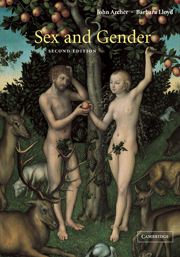Book contents
- Frontmatter
- Contents
- List of figures
- List of tables
- Preface
- 1 Commonsense beliefs and psychological research strategies
- 2 Stereotypes, attitudes, and personal attributes
- 3 Origins
- 4 Developmental influences
- 5 Sexuality: psychophysiology, psychoanalysis, and social construction
- 6 Aggression, violence, and power
- 7 Fear, anxiety, and mental health
- 8 The domestic sphere
- 9 Work, education, and occupational achievement
- 10 Looking back and looking ahead
- References
- Index
7 - Fear, anxiety, and mental health
Published online by Cambridge University Press: 11 May 2012
- Frontmatter
- Contents
- List of figures
- List of tables
- Preface
- 1 Commonsense beliefs and psychological research strategies
- 2 Stereotypes, attitudes, and personal attributes
- 3 Origins
- 4 Developmental influences
- 5 Sexuality: psychophysiology, psychoanalysis, and social construction
- 6 Aggression, violence, and power
- 7 Fear, anxiety, and mental health
- 8 The domestic sphere
- 9 Work, education, and occupational achievement
- 10 Looking back and looking ahead
- References
- Index
Summary
Introduction
The emotions of fear and anxiety that we examine in this chapter are closely linked with aggression, the subject of the previous chapter. Similar environmental conditions often produce fear, aggression, or both (Archer, 1988; Berkowitz, 1962). These emotions feature among the stereotypic traits associated with men and women, men being seen as more aggressive and women as more ‘emotional’ or fearful and anxious. Viewed in this way, ‘emotional’ excludes anger (chapter 2). Stereotypically, women who are overtly aggressive are seen as lacking femininity. Men who cry, seem afraid, or betray other negative emotions, are viewed as unmanly. Bravery, being able to endure pain and suffering without much overt distress or complaint, has traditionally been viewed as a masculine virtue. Throughout the world, manhood is regarded as something to be achieved by courageous actions – those that disregard the possibility of danger and physical pain (Gilmore, 1990). There are strong social pressures on men not to show the negative emotions of fear and anxiety, but women are permitted to do so, and even encouraged in such expressions, which is consistent with patriarchal notions of femininity. These social prescriptions have a long developmental history – boys are taught to avoid ‘feminine’ behaviour very early in life (chapter 4).
In the first part of this chapter, we address the issue of the difference between men and women in the expression of fear and anxiety. We then question whether mood swings are greater in women than men, and whether they are associated with fluctuations in women’s hormone levels, in particular during the premenstrual phase, postpartum, and following the menopause. In the major part of the chapter, we explore differences in the mental health of men and women.
- Type
- Chapter
- Information
- Sex and Gender , pp. 135 - 159Publisher: Cambridge University PressPrint publication year: 2002



